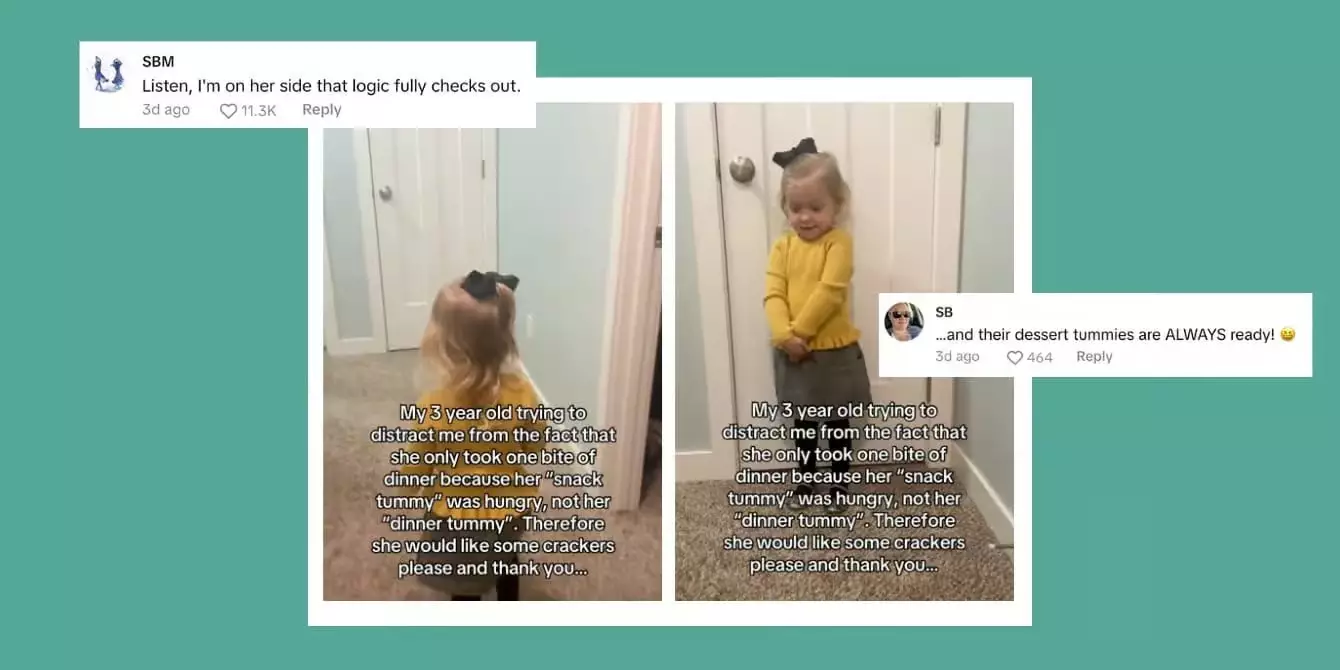If you’re a parent, you’ve undoubtedly faced the amusing yet frustrating reality of trying to convince your toddler to finish their dinner, only for them to insist they’re too full five minutes later—until a snack comes into play. This phenomenon, often affectionately dubbed the “snack tummy,” has been humorously recounted by countless parents around the globe. A recent viral TikTok featuring a little girl sharing her snack tummy versus dinner tummy theory has caught the hearts of many, garnering millions of views and nods of agreement from fellow parents. With her charming delivery and her clever logic, this toddler has transformed an everyday struggle into a collective laugh fest.
Her antics perfectly encapsulate the sheer chaos of feeding toddlers. If you’ve ever felt like mealtime with your little one is akin to navigating a comedic minefield, you’re not alone. The proclamation “I’m full!” following a brief encounter with their dinner plate often quickly morphs into, “Can I have a snack?” And parents endure this cycle, often finding solace in the shared experiences of other caregivers online.
The Humor in Everyday Chaos
What makes these whimsical moments so relatable isn’t just the sheer absurdity of a child insisting on separate “snack” and “dinner” tummies. The real laugh comes from recognizing that toddlers possess a sense of logic that defies adult reasoning. The TikTok comments section is overflowing with parents sharing their own food battles, proving that this isn’t just an isolated incident—it’s part of a broader phenomenon that connects and entertains. Remarks like “My kid convinced me his ribs are just shelves for food!” or “Every meal is a snack if he decides it is!” highlight a universal experience across parenting.
In a world where parenting can often feel isolating, these shared laughs serve as a crucial reminder of the precious, often hilarious moments that weave through the chaos. They encourage a form of camaraderie among parents, fostering a sense of belonging and humor amid the challenges of raising small children.
Understanding Toddler Eating Habits Through a Scientific Lens
Believe it or not, the playful logic of toddler eating is not merely a source of frustration—it’s rooted in developmental science. Research indicates that toddlers are naturally attuned to their hunger cues, representing the core principle of intuitive eating. Forcing kids to finish their plates can undermine their ability to self-regulate, creating unhealthy eating patterns down the line. This idea fundamentally shifts how parents can approach mealtime: instead of viewing it as a battle, they can embrace it as an opportunity for children to develop a healthy relationship with food.
The phenomenon known as sensory-specific satiety explains why toddlers might feign fullness for one meal but can suddenly seem ravenous for a different snack. The idea is simple yet powerful; familiarity breeds contempt. Once a child tires of their dinner, their appetite can reignite at the sight of something new—like Goldfish or cookies. Equipped with this knowledge, parents may discover the best way to approach mealtime is with flexibility, creativity, and, perhaps most importantly, a hefty dose of humor.
Strategies to Navigate Snack Tummy Logic
To make mealtime a more manageable affair, consider implementing creative strategies to reduce friction around food. First and foremost, honoring your child’s hunger cues is essential. Serve smaller portions to avoid overwhelming them, allowing for the possibility of second helpings if the first doesn’t do the trick. By presenting meals in bite-sized portions or charcuterie-style, you can make dinner feel less like chore and more like a fun snack feast, complete with cheese cubes and vibrant fruit.
Additionally, don’t underestimate the power of language. Sometimes, simply renaming dinner to “lunch” can make the meal feel more appealing to a toddler’s imaginative mindset. Engaging in playful dialogue about food can destigmatize mealtime and foster a positive connection with what they eat.
Incorporating nutritious snacks that double as treats can bridge the gap between mealtime demands and a child’s cravings. Ditching the notion that snacks are always separate from meals creates a licensing system for healthy choices. Think Greek yogurt with colorful berries or banana slices slathered in peanut butter; these combinations are not only appealing but also functional.
Embracing the Journey with Humor
Ultimately, acknowledging this whimsical toddler logic should be a source of joy rather than frustration. Parents should revel in the knowledge that these fleeting moments reveal their child’s burgeoning creativity and individuality. As a parent navigating this wild journey, when your toddler insists they can only chow down on cookies while declaring themselves “too full for dinner,” take a moment to breathe, laugh, and embrace the delightful chaos.
The concept of the “snack tummy” isn’t merely a quirky idiosyncrasy; it’s a reminder that navigating parenthood is an adventure filled with stories worth sharing. So the next time a mealtime battle unfolds at your table, remember that laughter is the best medicine. Your fellow caregivers are out there—commiserating, cheering you on, and probably chuckling at their own version of your misadventures.

